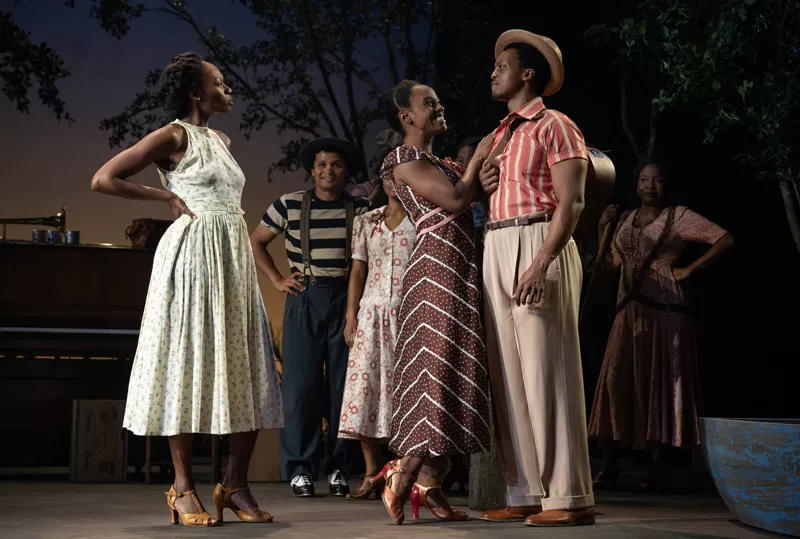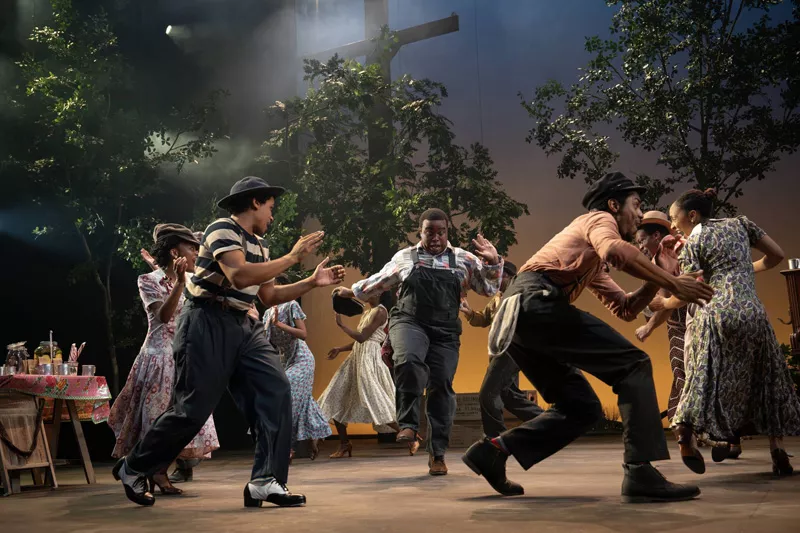“Spunk” at Yale Rep
Robert Schneider in New Haven, Connecticut
26 October 2025
★★★★★
The story of Zora Neale Hurston is one of a great talent too lightly solicited by the culture of her time. Her energies were dispersed hither and yon by nudges of encouragement and relatively small sums of money: a welcoming professor; a small grant, a private stipend. She careened from role to role: anthropologist, essayist, poet, journalist and— perhaps foremost—collector of folklore. In vogue during the Harlem Renaissance, she achieved middling success again in the 1930s and 1940s as a novelist. Then it faded.

Photo credit: Joan Marcus.
She died penniless in 1960, but her reputation has soared posthumously. The field of waist-high weeds that Alice Walker waded through in 1975 to find her unmarked grave is now tended like a veritable Arlington to her glory, her monument surrounded by a brick plaza and interpreted by a plaque.
As a dramatist, Hurston left unproduced works which we ruefully discover now. A published short play, Colour Struck, that makes impossible casting and staging demands; a collaboration with Langston Hughes that never happened; folk revue, The Great Day, that flopped on Broadway.
The manuscript of Spunk, copyrighted in 1935, was discovered in a folder in the Library of Congress in 2001 and made its way to Catherine Sheehy, the Resident Dramaturg at Yale Rep. Derived from a short story Hurston had published ten years earlier, this 90-year-old play with music finally premiered at Yale Rep in October. It sold out. The Rep has received three feelers for a possible transfer.
The Rep production took a good long while to put together. The manuscript included song titles but no music, sometimes not even lyrics, sometimes just a notation, “They sing a song here”. Nehemiah Luckett, music supervisor on the production, found most of the songs Hurston called for and wrote a few new ones when this proved impossible. The result is a disarming mixture of work songs, prison songs, folk, gospel and blues beautifully performed by the 15-member cast.

Photo credit: Joan Marcus.
Set in an all-black township like the one where Hurston grew up in the flat, orange-grove country of central Florida, the story is simple. A handsome stranger, Spunk Banks, walks into town one day along the railroad track playing his guitar. We rarely see him without that instrument. When he sings to it, he charms everyone. No one is immune. The townspeople recognize his charisma and admire his nerve; before long he’s got a dangerous, high-paying job at the sawmill and has attracted the attention of two local women. Unfortunately, the one he fancies most, Evalina, is married to a jealous and violent man. When the husband attacks Spunk with a razor, Spunk shoots him in self-defence. Sent to prison on a weapons charge (“White men don’t care when black folk kill each other”) Spunk charms even the guards. When he makes a run for freedom, one of them shoots but obligingly misses. He makes it back to town and the two women who love him. But Evalina’s ex-father-in-law, a Hoodoo conjuror, has also been waiting. He plans to revenge his dead son by putting a fatal curse on Spunk.
Full of high passions and fierce confrontations, the plot is positively operatic. You can squint at Spunk and see Lucia di Lammermoor. If the rural Black dialect is sometimes hard to understand, so is Italian—just think of it as an opera.
What Hurston does better than Donizetti —much better—is regale us with the everyday behaviour of her characters. Hurston’s ear for authentic speech and music is flawless, trained on years of fieldwork in the South. It’s not just the dialect she captures; her people have a uniquely elastic sense of metaphor and simile that is entertaining in itself. (The proprietor of a leaky rowboat available for hire is called “Admiral.”) She’s also unbeatable on southern festivities and games. Spunk incorporates a “toe dance” in which the women hide behind a curtain with only their toes visible. The men can “purchase” a toe for a dime and then treat the attached woman like royalty. (The choreography is by nicHi douglas.)
Hurston also bests Donizetti for an ending. She might easily have made the festivities go sour and dark—they do in her original short story—but she finds another way out, one that I found more satisfying.
Since Porgy and Bess, Black rural dialect, tainted by Ira Gershwin’s too-cute imitation, has been shunned on stage. Spunk shows us that it weren’t necessarily so. Since A Raisin in the Sun, Afro-American theatre has gone urban and contentious, largely defining Black culture through opposition to the majority culture that surrounds and contains it. It lost track of that part of Black culture that is autonomous and joyous and answers only to itself. What Hurston wrote about herself (in an essay intitled “How It Feels to Be Coloured Me”) is also true of her characters:
I am not tragically coloured. There is no great sorrow dammed up in my soul, nor lurking behind my eyes. I do not mind at all. I do not belong to the sobbing school of Negrohood who hold that nature somehow has given them a lowdown dirty deal and whose feelings are all but about it. Even in the helter-skelter skirmish that is my life, I have seen that the world is to the strong regardless of a little pigmentation more or less. No, I do not weep at the world–I am too busy sharpening my oyster knife.
Under Tamilla Woodard’s direction, the cast at Yale Rep is irresistible. J. Quinton Johnson as Spunk and Kimber Elayne Sprawl as Evalina sing a love duet in Admiral’s rowboat. Kimberly Marable, as Spunk’s rejected lover, sings a wonderful blues number in the second act. Naiqui Macabroad as the wronged husband and Charlie Hudson III as the Hoodoo Conjuror nicely convey a father-and-son cocktail of menace and inadequacy.
The ensemble voices are enchanting whether together or apart. There are 30 musical numbers in all.
Scenic designer Karen Loewy Movilla and lighting designer Gib Gibney open the proscenium as far as the theatre architecture permits to create a vast, heaven-vaulted space, an outdoors that feels like a cathedral. Kristen Taylor’s costumes prove that poverty doesn’t impose monotony—far from it.
I’m sorry to report that the plague of paltry and unpredictable small sums of money that plagued Hurston in her lifetime is still with us. The production was awarded a $30,000 grant from the National Endowment for the Arts only to see it rescinded earlier this year with the following explanation: “The NEA is updating its grant-making policy priorities to focus funding on projects that reflect the nation’s rich artistic heritage and creativity as prioritized by the President.”
How or why this long-delayed premiere of Spunk isn’t one of those “rich artistic heritage” projects is a mystery to me. It should be in the first rank.









